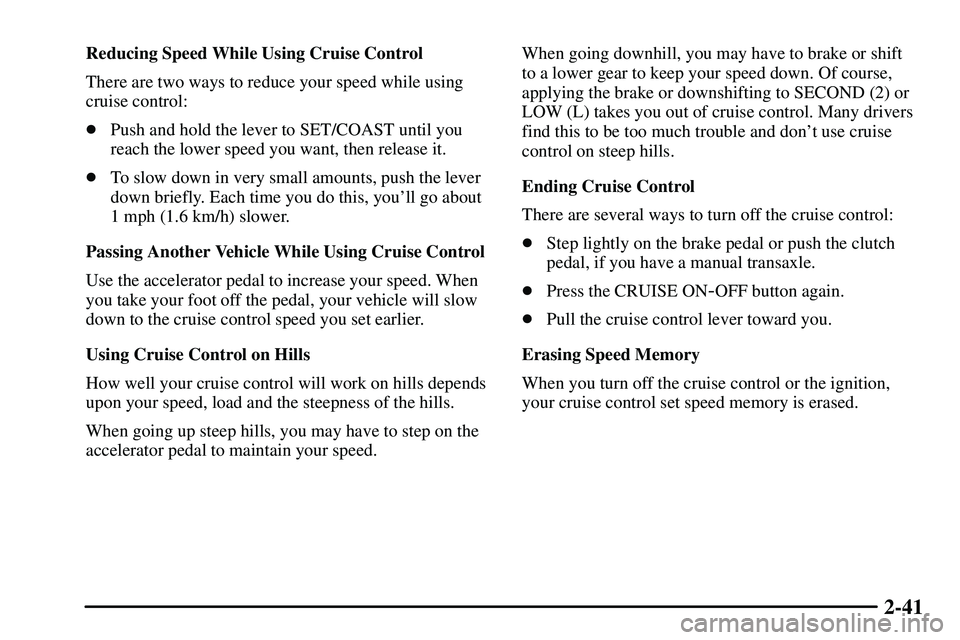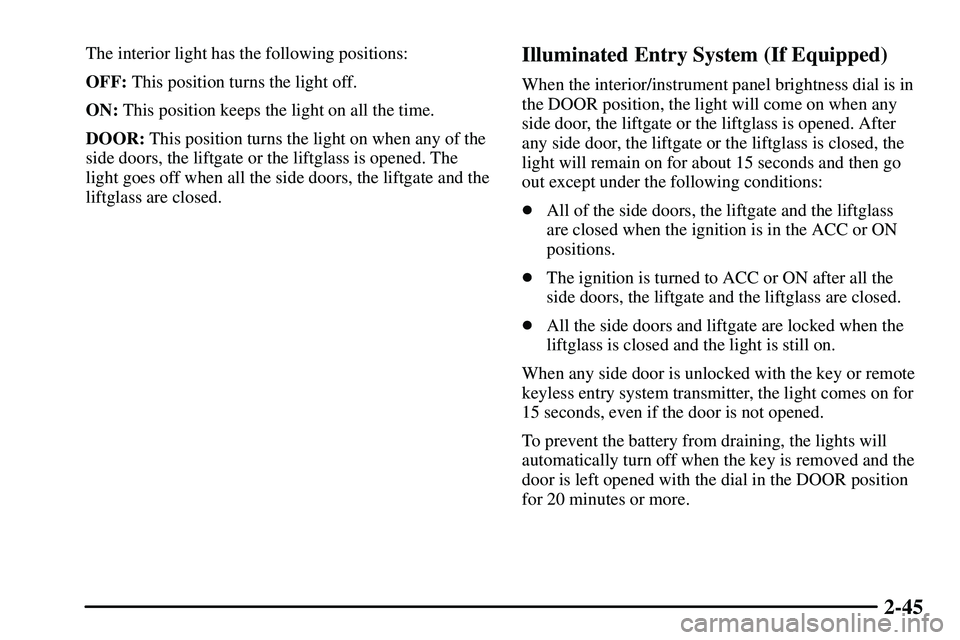Page 105 of 381

2-41
Reducing Speed While Using Cruise Control
There are two ways to reduce your speed while using
cruise control:
�Push and hold the lever to SET/COAST until you
reach the lower speed you want, then release it.
�To slow down in very small amounts, push the lever
down briefly. Each time you do this, you'll go about
1 mph (1.6 km/h) slower.
Passing Another Vehicle While Using Cruise Control
Use the accelerator pedal to increase your speed. When
you take your foot off the pedal, your vehicle will slow
down to the cruise control speed you set earlier.
Using Cruise Control on Hills
How well your cruise control will work on hills depends
upon your speed, load and the steepness of the hills.
When going up steep hills, you may have to step on the
accelerator pedal to maintain your speed.When going downhill, you may have to brake or shift
to a lower gear to keep your speed down. Of course,
applying the brake or downshifting to SECOND (2) or
LOW (L) takes you out of cruise control. Many drivers
find this to be too much trouble and don't use cruise
control on steep hills.
Ending Cruise Control
There are several ways to turn off the cruise control:
�Step lightly on the brake pedal or push the clutch
pedal, if you have a manual transaxle.
�Press the CRUISE ON
-OFF button again.
�Pull the cruise control lever toward you.
Erasing Speed Memory
When you turn off the cruise control or the ignition,
your cruise control set speed memory is erased.
Page 106 of 381
2-42
Exterior Lamps
The lever on the left side of the steering column
operates the exterior lamps.
(Exterior Lamps): Turn the outside part of the
lever with the symbol on it, to operate the lamps.The exterior lamp switch has three positions:
OFF: Turning the switch to this position turns off all
lamps, except the Daytime Running Lamps (DRL).
� (Parking Lamps): Turning the switch to this
position turns on the parking lamps together with the
following:
�Sidemarker Lamps
�Taillamps
�License Plate Lamp
�Instrument Panel Lights
(Headlamps): Turning the switch to this position
turns on the headlamps, together with the previously
listed lamps and lights.
Turn the switch to OFF to turn off the lamps.
(Fog Lamps): You can also use the control lever to
turn on the fog lamps.
Page 107 of 381

2-43 Automatic Light Control (ALC)
Your vehicle is equipped with an automatic light sensor
on the top left corner of the instrument panel, so be
sure it is not covered or the headlamps will be on
continuously.
When it is dark enough outside, your ALC will turn on
your low
-beam headlamps at the normal brightness
along with other lamps such as the taillamps,
sidemarker, parking lamps and instrument panel lights.
The parking brake must be released for ALC to work.
This is indicated by the headlamp symbol on your
instrument panel cluster.
If you are driving through a parking garage, overcast
weather, or a tunnel, the ALC may turn on your
low
-beam headlamps at a normal brightness along with
the taillamps, sidemarker, parking lamps and the
instrument panel lights. The radio lights will be dimmer,
and the instrument panel cluster lights may dim. There
will be a 10 to 15 second delay before the lights will
turn on when starting the car at night.
Lamps On Reminder
If you turn the ignition to LOCK or ACC and leave
the lamps on, you'll hear a tone when you open the
driver's door.
Daytime Running Lamps
Daytime Running Lamps (DRL) can make it easier for
others to see the front of your vehicle during the day.
DRL can be helpful in many different driving
conditions, but they can be especially helpful in the
short periods after dawn and before sunset. Fully
functional daytime running lamps are required on all
vehicles first sold in Canada.
The DRL system will make your headlamps come
on at a reduced brightness when the following
conditions are met:
�The ignition is on with the engine running,
�the exterior lamps switch is off and
�the parking brake is released.
When the DRL are on, only your headlamps will be on
at a reduced brightness. The taillamps, sidemarker and
other lamps won't be on. Your instrument panel won't
be lit up either.
When you turn the exterior lamp switch to the headlamp
position, your DRL will go off and your headlamps will
come on. The other lamps that come on with your
headlamps will also come on.
Page 108 of 381

2-44
When it begins to get dark, the headlamps will
automatically switch from DRL to the regular
headlamps. See ªAutomatic Light Controlº earlier in
this section.
When you turn the exterior lamp switch off, the regular
lamps will go off and your headlamps will change to the
reduced brightness of DRL provided it is not dark
outside. DRL also comes on if only the parking lamps
are being used.
To idle your vehicle with the DRL off, do the following:
1. Set the parking brake.
2. Turn the ignition off.
3. Turn the ignition back on.
The DRL will stay off until you release the
parking brake.
As with any vehicle, you should turn on the regular
headlamp system when you need it.Interior Lamps
Interior/Instrument Panel Brightness Dial
The interior/instrument
panel brightness dial is
located to the left of the
steering wheel on the
instrument panel.
The brightness of the instrument panel lights will not
decrease when the headlamps are on. It is recommended
that the brightness level is kept at the maximum setting
for all daytime driving to insure proper visibility.
Page 109 of 381

2-45
The interior light has the following positions:
OFF: This position turns the light off.
ON: This position keeps the light on all the time.
DOOR: This position turns the light on when any of the
side doors, the liftgate or the liftglass is opened. The
light goes off when all the side doors, the liftgate and the
liftglass are closed.Illuminated Entry System (If Equipped)
When the interior/instrument panel brightness dial is in
the DOOR position, the light will come on when any
side door, the liftgate or the liftglass is opened. After
any side door, the liftgate or the liftglass is closed, the
light will remain on for about 15 seconds and then go
out except under the following conditions:
�All of the side doors, the liftgate and the liftglass
are closed when the ignition is in the ACC or ON
positions.
�The ignition is turned to ACC or ON after all the
side doors, the liftgate and the liftglass are closed.
�All the side doors and liftgate are locked when the
liftglass is closed and the light is still on.
When any side door is unlocked with the key or remote
keyless entry system transmitter, the light comes on for
15 seconds, even if the door is not opened.
To prevent the battery from draining, the lights will
automatically turn off when the key is removed and the
door is left opened with the dial in the DOOR position
for 20 minutes or more.
Page 117 of 381
2-53
Ashtrays and Cigarette Lighter
NOTICE:
Don't put papers and other things that burn into
your ashtray. If you do, cigarettes or other
smoking materials could set them on fire, causing
damage.
To use the lighter, push the lighter in all the way and let go.
When it's ready, it will pop back out by itself. If the engine
is not running, the key must be in ACC to use the lighter.
NOTICE:
Don't hold a cigarette lighter in with your hand
while it is heating. If you do, it won't be able to
back away from the heating element when it's
ready. That can make it overheat, damaging the
lighter and the heating element.
Your vehicle has a removeable ashtray that sits in your
front cupholder in the center console storage area.
Sun Visors
To block out glare, you can swing down the visors.
You can also swing them to the side.
Visor Vanity Mirror
Swing down the driver's sun visor and lift the cover to
expose the vanity mirror.
Page 119 of 381

2-55
Power Outlet 115 Volts Alternating
Current (VAC)
With this power outlet, you can plug in auxiliary
electrical equipment with a maximum limit of 115 VAC.
If you try to use equipment that requires more than the
limit, a protection circuit will cut the power supply. The
power will automatically restart when equipment that
operates within the limit is plugged in.
The power outlet is located near the center of the
instrument panel. Before using the outlet, turn on the
ignition and press the button next to the outlet. An
indicator light in the button will come on. After using
the outlet, press the button again to turn it off.
The power outlet is not designed for the following
electrical equipment and they may not work properly:
�Equipment with high initial peak wattage:
cathode
-ray tube type televisions, compressor-driven
refrigerators, electric power tools.
�Other equipment requiring an extremely stable
power supply: microcomputer
-controlled electric
blankets, touch sensor lamps, etc.
Page 123 of 381
2-59
The main components of your instrument panel are the following:
A. Air Outlets
B. Instrument Panel Cluster
C. Hazard Warning Flasher Button
D. Audio System
E. Rear Window Defogger Button
F. Front Passenger Safety Belt Reminder Light
G. Comfort Control System
H. Power Remote Control Mirror Button
I. Instrument Panel Brightness Dial
J. Rear Liftglass Release Button
K. Coinholder
L. Content Theft
-Deterrent Security Light
M. Storage CompartmentN. Turn Signal/Multifunction Lever
O. Hood Release
P. Tilt Lever
Q. Horn
R. Cruise Control Lever (Option)
S. Ignition Switch
T. Windshield Wiper Lever
U. Cigarette Lighter
V. Shift Lever
W. Power Outlet
X. Parking Brake
Y. Center Console Storage Area
Z. Glove Box